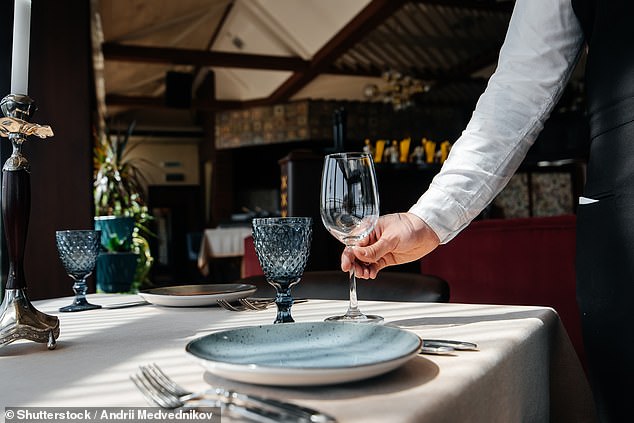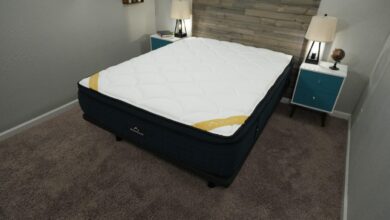I am a restaurant designer – and that is why the TOILET is one of the most important spaces in a cafe

A poorly designed restaurant can spoil the appetite.
That’s why restaurant owners should pay special attention to these tips from Dale Atkinson, founder of the London-based interior design firm Rosendale designwhich has been commissioned to work on three new restaurants for Michelin star chef Jason Atherton.
Here, Dale reveals the common mistakes in restaurant design, the key signs you’re in a well-thought-out eatery – and why owners should pay special attention to the appearance of the restrooms.
What are the most common mistakes in restaurant design?
Dale told MailOnline Travel: ‘The first fault I always see in restaurants that are poorly designed is the lighting.

Dale Atkinson, founder of interior architecture studio Rosendale Design, has revealed his top tips for a well-designed restaurant (stock image)
‘Sometimes there are far too many downlights and you get a “flat lit” room. Well lit rooms are usually warm and inviting, and the lighting is achieved by layering.
‘What is particularly annoying is when there is beautiful mood lighting, which is disrupted by open and cool light entering the room every time maintenance is carried out.
‘Another aspect of a poorly designed dining space is when the tables are crammed together and there is no space and you are essentially sitting with the table next to you.
‘You can hear each other’s conversations, which is annoying.
‘Finally, there is furniture that is uncomfortable and has poor ergonomics. This is most often seen in sofa seating, where nothing is worse than a thinly padded seat and a completely vertically straight back.’
What are the most important characteristics of a well-thought-out restaurant?

Dale mentions Rue Du Liban in Mumbai, above, as a restaurant with great lighting
Dale told MailOnline: ‘A well-lit room can go a long way in a restaurant. A lighting installation that is layered and includes key features can help a design take root, as in Rue Du Liban, Mumbai (pictured).
‘Obviously you can’t achieve everything with lighting, but it is one of the most important aspects of any room.
‘Think about this, you’re in a white box room and you have a series of fluorescent lights on the ceiling. This room would be flatly lit and very bright.

Dale reveals he is proud of the toilets he designed at Mallow (above) in London’s Canary Wharf
‘But if you take the same room and just put a candle in the middle, the room suddenly becomes darker and very romantic.
‘Acoustics are also important. If you enter a room and can no longer hear your own conversation, it can ruin your evening.
‘Lots of soft furnishings and details can help to suppress echo and create a pleasant atmosphere, while also creating a comfortable space.
Keeping a few areas out of sight also helps.
Dale explains: ‘A key aspect of a well-designed restaurant is that not all the spaces are immediately visible, and that the designers create a journey where the space opens up. This helps the restaurant because when guests return, they don’t always have the same experience, because they may be in a different space.
‘One aspect of the journey that you always experience in a restaurant is the restrooms, but surprisingly they are often overlooked or undervalued. Yet they are one of the most important spaces in a restaurant.
‘If you’re in a well-appointed restaurant, you know that the restrooms are just as impressive as the main dining room.
‘One of my favourite toilets I designed was in Mallow (pictured), in London’s Canary Wharf. We used colour to bring it to life.’
How important is the entrance and what can a restaurant do to make it welcoming?

The entrance is “an important part of the customer journey,” says Dale. Above – his design for the entrance to KingsSocial at Badrutts Palace in St. Moritz. The designer said: ‘This was an Instagrammable feature and very popular’
Dale said: ‘I once had a conversation with a Michelin inspector and they made a very interesting comment that has stuck with me ever since: ‘A consumer’s first bite is always taken with their eyes.’
‘It’s like the old saying, “You never get a second chance to make a first impression.” So the entrance is really one of the most important parts of the customer journey. If you’re not able to capture their imagination or interest at this point, then you’re fighting an uphill battle from here on out.’
Dale encourages restaurant owners to think about placing an eye-catching installation at the entrance that guests can take a photo of and post to social media.
He continued: “A great example of an entrance feature that really piques people’s interest is the light tunnel we created for KingsSocial, at the legendary Badrutts Palace in St. Moritz. Here, the first experience of the space upon entering is a long staircase that takes you to the main room. To make this journey unforgettable, we have introduced arches of color-changing LEDs leading downwards. This was an Instagrammable feature and very popular. It is often talked about and mentioned on various social media.”
How can a restaurant improve its design on a budget?

Dale said: ‘A good rule of thumb for where to spend money on a project is on the key touchpoints. This means where the consumer is likely to come into contact with the most. For example, every customer is going to touch and interact with the dining table’

Designer Dale Atkinson
Dale said, “One of the best things you can do when redesigning a restaurant on a budget is to try to use as much of what’s already there, but change it on the surface. This might mean keeping some of the existing wood paneling or flooring, sanding it back and re-staining it. It might mean keeping some of the plain doors and adding some molding to them to add some visual interest.”
Where should an owner invest his or her money when it comes to design?
Dale said, “A good rule of thumb for spending money on a project is the most important touchpoints.
‘This means where the consumer is likely to interact the most. For example, every customer is going to touch and interact with the dining table, so if you install a cheap melamine table top with a plywood substrate and you can see the layers of plywood on the edge of the table, customers will know and see that it is cheap.’
Are there certain design elements you see in restaurants that readers can implement at home?
When you are in a well-designed restaurant, you know that the restrooms are just as impressive as the main dining room
Dale revealed, “I think there are a lot of crossovers that can work in homes as well as restaurants. In one of our residential projects we used curved seating areas in the kitchen to create soft seating where the family could stretch out and relax, seeing the kitchen as the central hub where the whole family gathered most of the time.
‘Again, lighting can play an important role and many of the lighting details we use in restaurants can be used at home to create features in the dining room or kitchen. Of course, it can also simply be a characteristic hanging lamp above a dining table. This is just as important in restaurant design as it is in our residential projects.
‘Finally, a design aspect that we often take from restaurant design and use in residential design is making a feature of a glassware storage or drinks cabinet – and even a feature wine cellar can be a great feature and talking point in any home when it comes to entertaining guests.’
For more information from Rosendale Design, visit www.instagram.com/rosendaledesign.




